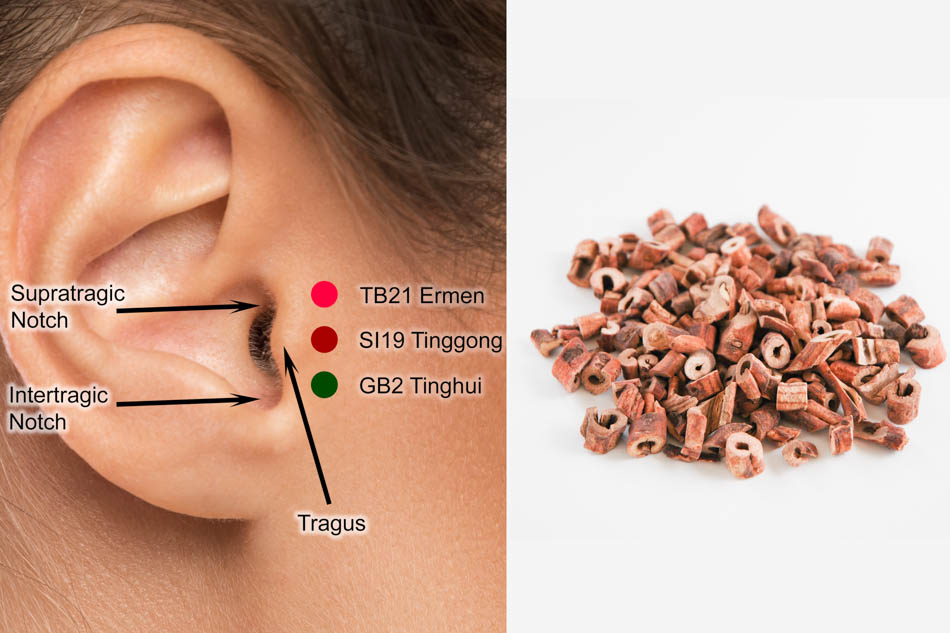
Hebei University researchers demonstrated that acupuncture and integrated herbal medicine interventions provide measurable therapeutic benefits in the treatment of sudden sensorineural hearing loss (SSNHL) and tinnitus [1]. SSNHL is defined as an idiopathic hearing impairment of at least 30 dB affecting three contiguous frequencies within 72 hours and has long posed difficulties for clinical management due to the limited efficacy of conventional pharmacological approaches [1]. Evidence from randomized controlled trials and preclinical investigations shows that acupuncture, particularly electroacupuncture, significantly improves auditory thresholds, while classical prescriptions such as Er Long Zuo Ci Wan (耳聋左慈丸, ELZCW) preserve cochlear hair cell function through well-defined molecular pathways [1].
Acupuncture protocols for SSNHL consistently focus on peri-auricular acupoints, including Ermen (TB21), Yifeng (SJ17), Tinggong (SI19), and Tinghui (GB2) [1]. Stainless steel filiform needles measuring 0.25 millimeters in diameter are inserted perpendicularly to depths of approximately 15 to 25 millimeters, adjusted according to patient sensitivity and auricular anatomy. Manual techniques involve alternating lifting-thrusting and twirling until the arrival of deqi is elicited, after which needles are retained for 20 to 30 minutes.
Treatment is commonly administered once daily or every other day over a two- to three-week course [1]. Electroacupuncture modifies this protocol by delivering pulsed low-frequency currents of 2 to 4 Hz through 0.25 × 25 millimeter needles inserted at peri-auricular points such as TB21 and GB2. Current intensity is titrated until mild peri-auricular muscle twitching is observed, and retention is maintained for 30 minutes. This dual mechanical and electrical stimulation has been shown to enhance local hemodynamics, reduce blood viscosity, and modulate neuronal excitability, thereby improving cochlear circulation and metabolic function [1].
Clinical investigations have reported that acupuncture combined with conventional therapies such as corticosteroid administration results in greater improvements in pure-tone auditory thresholds than standard pharmaceutical treatment alone [1]. Electroacupuncture produces superior outcomes compared with manual acupuncture, particularly in the acute phase of idiopathic SSNHL, where it yields larger reductions in threshold shifts between 2 and 4 kHz and more substantial improvements in speech recognition [1]. In patients with tinnitus, manual acupuncture decreases symptom severity as measured by validated scales including the Tinnitus Handicap Inventory and the Tinnitus Severity Index. These effects extend to improved sleep quality and reduced psychological distress. Electroacupuncture with embedding techniques and prolonged retention further amplifies these benefits, producing more sustained symptom relief [1].
Biomedical studies support these clinical findings with mechanistic evidence. Acupuncture has been shown to reduce oxidative stress in cochlear tissues by activating NRF2 signaling pathways and decreasing the generation of reactive oxygen species. In animal models, peri-auricular acupuncture decreased gentamicin-induced ototoxicity by attenuating free radical activity, while electroacupuncture applied both before and after noise exposure accelerated auditory recovery and preserved synaptic ribbon structures and spiral ganglion neurons [1]. These effects confirm that acupuncture enhances antioxidant defenses and preserves cellular integrity within the cochlea, mechanisms that align with the traditional Chinese medicine principle of promoting qi and blood circulation to the auditory orifices [1].
Herbal prescriptions provide complementary effects. Er Long Zuo Ci Wan, a modification of Liu Wei Di Huang Wan with the addition of magnetite (Ci Shi) and bupleurum (Chai Hu), has demonstrated significant clinical efficacy in auditory disorders. In randomized controlled trials, patients receiving Er Long Zuo Ci Wan combined with sound therapy achieved superior auditory outcomes compared with sound therapy alone, with no reported adverse events [1]. Mechanistic studies show that Er Long Zuo Ci Wan downregulates the pro-apoptotic p53/Bak pathway, modulates ERK and STAT3 signaling, and maintains mitochondrial integrity in cochlear hair cells, thereby delaying auditory threshold elevation and preserving cochlear function [1]. Other formulas, including Tong Qiao Er Long Wan (通窍耳聋丸, TQELW), improve hemorheological parameters when combined with corticosteroids such as dexamethasone, while Zuo Gui Wan (左归丸, ZGW) with reed-stem moxibustion reduces tinnitus severity and enhances sleep quality in patients diagnosed with kidney essence deficiency patterns [1].
Objective biomedical findings substantiate these outcomes. In murine models, Er Long Zuo Ci Wan delayed the elevation of auditory thresholds and preserved both cochlear hair cells and spiral ganglion neurons [1]. Yinxing (Ginkgo biloba, 银杏) extract reduced noise-induced synaptic loss and preserved auditory nerve function, while Radix Astragali (Huang Qi, 黄芪) therapy in SSNHL patients enhanced cochlear microcirculation and produced statistically significant improvements in hearing recovery and tinnitus resolution [1]. At the molecular level, polyphenols such as caffeic acid and resveratrol downregulated NF-κB and IL-1β expression, thereby attenuating inflammatory damage in cochlear cells [1].
Overall, these results outline a therapeutic framework for licensed acupuncturists, while clinical application must always be guided by individual differential diagnosis and case-specific evaluation. Peri-auricular acupuncture using TB21, SJ17, SI19, and GB2 with 0.25 × 25 millimeter needles, applied daily or every other day with 20 to 30 minutes retention, is supported by both clinical and mechanistic data. Electroacupuncture at low-frequency stimulation enhances therapeutic outcomes, particularly in acute SSNHL. Integration of classical formulas such as Er Long Zuo Ci Wan, Tong Qiao Er Long Wan, and Zuo Gui Wan, tailored to syndrome differentiation, further improves efficacy. These interventions not only produce subjective improvements in tinnitus and hearing perception but are corroborated by objective measures including auditory threshold shifts, synaptic preservation, mitochondrial integrity, and modulation of apoptotic and inflammatory pathways [1]. Challenges to integrating the recommended evidence-based treatment frequency include both access to care and the affordability of care.
Source:
[1] Zhao M, Zhou Y. Traditional Chinese Medicine Interventions for Auditory Disorders: Mechanisms and Clinical Evidence Supporting the Management of Hearing Loss and Tinnitus. Neuropharmacology and Therapy. 2025;2(1):26–42.